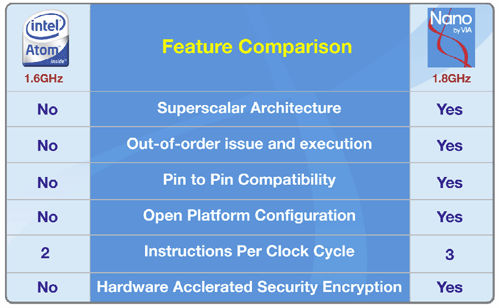VIA Nano L2100 vs. Intel Atom 230: Head to Head
VIA caused quite a stir a few months ago when the company first revealed initial details regarding their low-power Nano processor. At the time, the product was referred to by its internal codename of Isaiah. In addition, the President of VIA's design center that was tasked with making the processor, was decidedly outspoken, which made for some exciting reporting.
When news of the Isaiah core first broke, we hopped on the phone with Glenn Henry, VIA's Centaur design center president, and got many questions answered regarding the processor's architecture, features, expected performance, and the company's plans for the CPU. We strongly suggest checking that article out because we won't be rehashing much of the data here--Glenn Henry's exact works are available for download at the end of the piece, as is VIA's Isaiah Architecture FAQ. We have also covered the official announcement of the VIA Nano processor and detailed the exact models that would be available at launch. In this piece, we were also able to disclose more architectural details, which may interest many of you who are interested in the intricate details of the chip's inner workings.
One thing we hadn't been able to give you all, however, was a direct performance comparison of the VIA Nano processor versus Intel's recently released Atom, which is target at the same market segment. Thankfully, we were recently given the opportunity to take a VIA Nano reference platform for a spin to see what it could do and will be presenting our results for you here today.
First up, just to reiterate some of the information we have covered in previous articles, here is an outline of the main features of the VIA Nano processor and a short comparison between the Nano and Atom.
- 64-bit Superscalar Speculative Out-Of-Order MicroArchitecture: Supports a full 64-bit instruction set and provides for macro-fusion and micro-fusion functionality, and sophisticated branch prediction for greater processor efficiency and performance.
- High-Performance Computation and Media Processing: The high-speed, low power VIA V4 Front Side Bus starting at 800MHz, plus a high speed floating point unit, support for new SSE instructions, and two 64KB L1 caches and 1MB exclusive L2 cache with 16-way associativity gives a big boost to multimedia performance.
- Advanced Power and Thermal Management: Aggressive management of active power includes support for the new “C6” power state, Adaptive PowerSaver Technology, new circuit techniques and mechanisms for managing the die temperature, reducing power draw and improving thermal management.
- Scalable Upgrade to VIA C7 Processor: Pin-to-pin compatibility with current VIA C7 processors enables a smooth transition for OEMs and mainboard vendors, enabling them to offer a wider range of products for different markets with a single board or system design.
- Greener Technology: In addition to full compliance with RoHS and WEEE regulations, product manufacturing will be halogen-free and lead-free at launch, helping to promote a cleaner environment and more sustainable computing.
- Enhanced VIA PadLock Security Engine: Industry-leading on-die hardware cryptographic acceleration and security features, including dual quantum random number generators, an AES Encryption Engine, NX execute protection, and SHA-1 and SHA-256 hashing.

To test the VIA Nano processor, we received a mini-ITX reference platform, that was originally designed for the C7 core. But because the Nano is pin-compatible with the C7, VIA was able to solder a Nano right onto the existing board.
VIA Nano Reference Platform with 1.8GHz Nano L2100 Processor
We should note, however, what you see pictured above will not be made available to consumers. This platform was put together strictly for testing purposes and won't be put up for sale. With that said, we're hoping something similar comes to market because it has some interesting features. Obviously the mini-ITX form factor is desirable for assembling ultra small systems. But we also like the integrated mini-PC slot, PCI Express slot, and Compact Flash adapter. Slap a 32GB compact flash card in this puppy, along with a wireless adapter, and you've got a great foundation for durable, low power car-computer.
Powering this platform was a VIA Nano L2100 processor clocked at 1.8GHz, with a VIA CN896 North Bridge and VT8251 South Bridge, and integrated Chrome9 HC graphics. Unfortunately, this beta platform stopped working for us after a couple of days and we couldn't experiment with it as much as we would have liked in time for this article. Hopefully we'll have a replacement soon and can plug in some more details for you all later.
Intel BOXD945GCLF with 1.6GHz Atom 230 Processor
For comparison purposes, we also got out hands on Intel's BOXD945GCLF which comes complete with a 1.6GHz Atom 230 processor. The BOXD945GCLF features an Intel 945GC Northbridge with an ICH7 Southbridge and integrated GMA950 graphics. For more details regarding the Atom processor architecture and the chipset powering this platform, please refer to our coverage of the Atom launch and the 945 chipset introduction available here.






